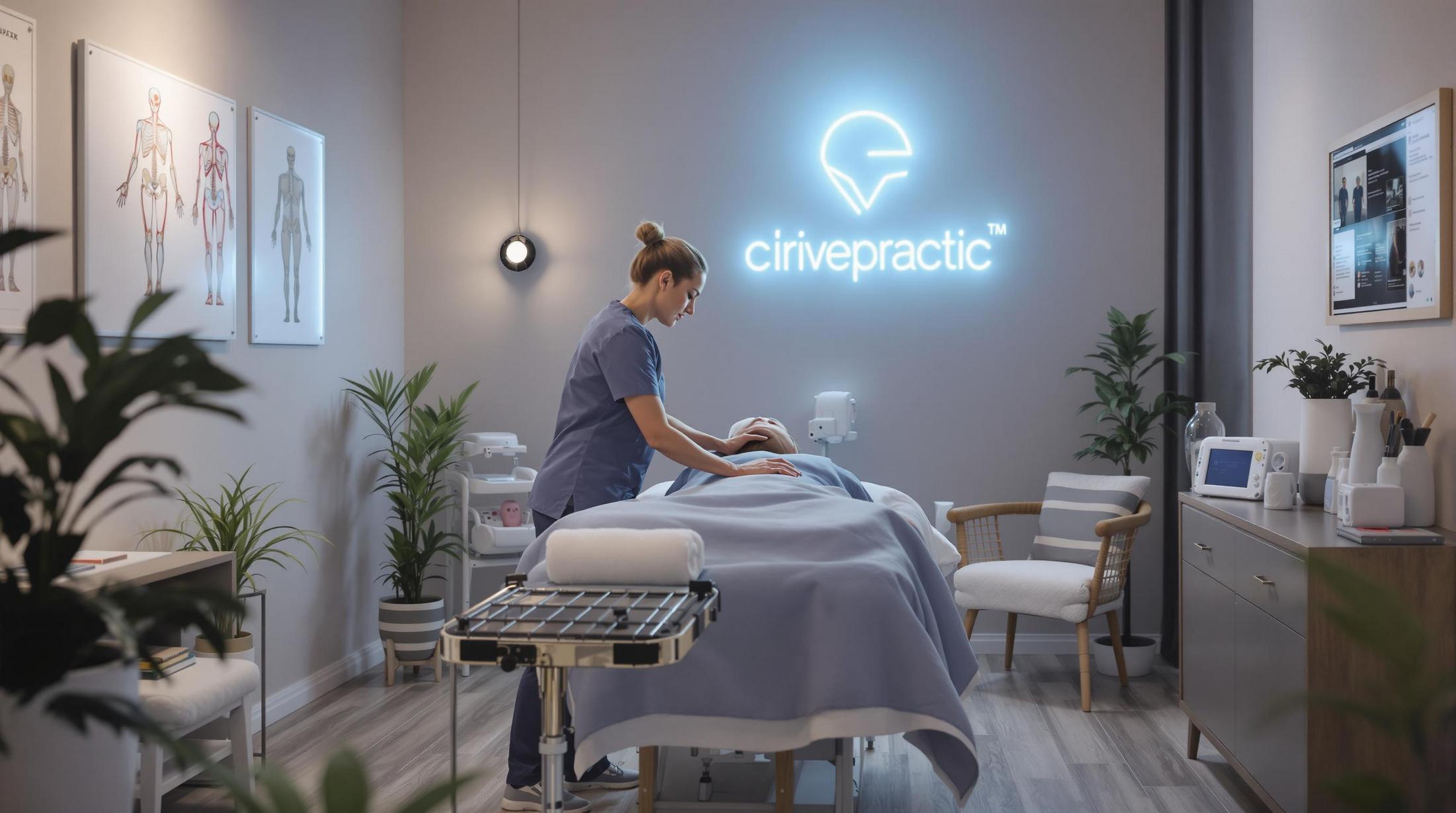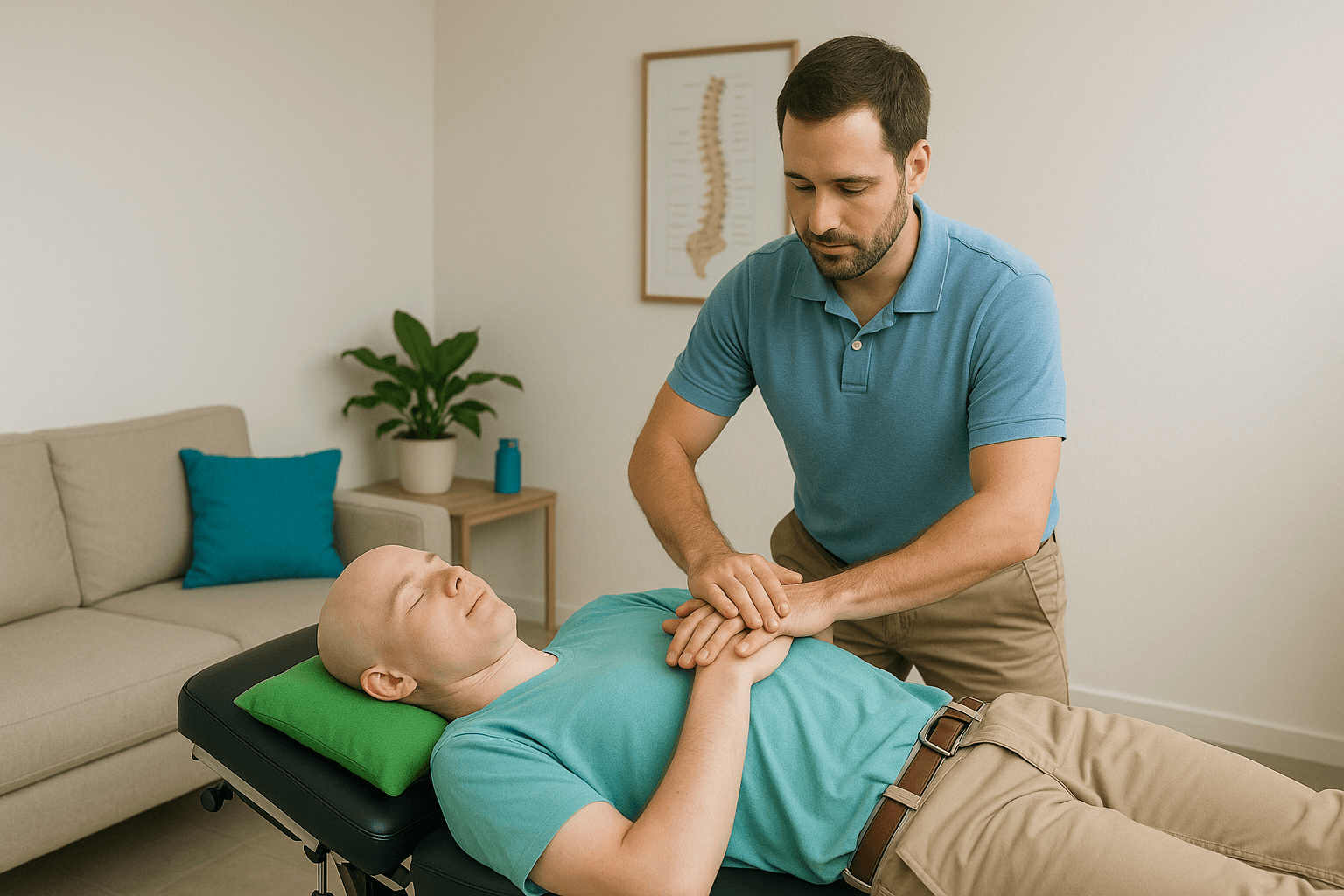
Jump To:
- Understanding TMJ Disorder
- 1. Chiropractic Care for TMJ Disorder
- 2. Medications
- 3. Physical Therapy
- 4. Stress Management and Behavioral Therapy
- 5. Dental Interventions
- 6. Surgical Options
- 7. Alternative Therapies
- 8. Nutrition and Lifestyle Changes
- Our TMJ disorder treatment
- What to Expect During a Chiropractic Visit
- Conclusion
- Taking the Next Step
- Key Takeaways
- FAQs
TL;DR – Quick Guide
TMJ disorder affects the jaw joint and surrounding muscles, leading to pain, restricted movement, and discomfort. Many treatments exist, including chiropractic care, medications, dental interventions, physical therapy, and even surgery for severe cases.
Advanced BioStructural Correction (ABC™) is a chiropractic approach that focuses on correcting misalignments in the spine, face, and cranium, which often contribute to TMJ pain. This non-invasive treatment helps relieve jaw tension, improve posture, and enhance overall body function.If you’re struggling with jaw pain, clicking, headaches, or difficulty chewing, consider chiropractic care as a safe and effective solution. Contact us today for a consultation.
Temporomandibular Joint Disorder (commonly referred to as TMJ or TMD) is a condition that affects the jaw joint and surrounding muscles, often leading to discomfort, pain, and restricted jaw movement. For those experiencing TMJ symptoms, finding effective TMJ disorder treatment can feel overwhelming. Chiropractic care, an often-overlooked option, can be a highly effective approach for addressing TMJ issues.
In this blog, we’ll explore TMJ, its symptoms and causes, and how chiropractic care can play a vital role in providing relief and improving overall jaw function. Additionally, we’ll cover all available TMJ disorder treatment options to help you make an informed decision, including their pros, cons, and approximate costs.
Understanding TMJ Disorder
The temporomandibular joints connect the lower jaw (mandible) to the skull on each side of the face. These joints are essential for activities like chewing, speaking, and swallowing. When the joints or surrounding muscles experience dysfunction, it can result in TMJ disorder.
Common Symptoms of TMJ Disorder
- Jaw pain or tenderness
- Clicking or popping sounds when opening or closing the mouth
- Difficulty or discomfort while chewing
- Locking of the jaw
- Headaches or migraines
- Earaches or a sensation of fullness in the ears
- Neck and shoulder pain
Potential Causes of TMJ Disorder
- Misalignment of the jaw or teeth
- Bruxism (teeth grinding or clenching)
- Trauma to the jaw or face
- Arthritis in the temporomandibular joint
- Stress, which can lead to muscle tension
- Poor posture which affects the alignment of the spine and jaw
1. Chiropractic Care for TMJ Disorder
How It Works
Our form of chiropractic care is called Advanced BioStructural Correction. The method focuses on aligning the musculoskeletal system, and we have found almost 100% of our TMJ disorder patients achieve relief from TMJ-related discomfort and pain. Misalignment of the spine, face and cranium (head) can be the sole cause of TMJ symptoms. Our chiropractors employ this specific method to address these issues and restore balance to the entire body. This method also includes Endonasal Cranial Correction to improve facial and cranial bone alignment. We also give ergonomic training using specifically designed pillows, seat wedges and shoes to help keep your body in alignment for longer-term health and wellness.
Pros:
- Non-invasive and drug-free
- Addresses underlying causes such as posture and alignment
- A holistic approach to overall wellness
Cons:
- Requires multiple sessions for optimal results
- It may not fully resolve the most severe TMJ cases
Approximate Cost:
£40–£80 per session, with multiple sessions often recommended.
2. Medications
How It Works
Medications can help manage pain and reduce inflammation or muscle tension associated with TMJ disorder.
Pros:
- Provides quick symptom relief
- Readily available over-the-counter or by prescription
Cons:
- Temporary relief; does not address the root cause
- Potential side effects from prolonged use
Approximate Cost:
- Over-the-counter pain relievers: £8–£24
- Prescription medications: approx £10
3. Physical Therapy
How It Works
Physical therapists provide exercises and stretches tailored to strengthen the jaw and surrounding muscles, improving alignment and mobility.
Pros:
- Non-invasive and highly effective for many patients
- Helps improve jaw strength and function
Cons:
- Requires a time commitment for exercises and appointments
- It may take weeks to see significant improvement
Approximate Cost:
£40–£80 per session, with several sessions typically required.
4. Stress Management and Behavioral Therapy
How It Works
This approach targets stress and behavioural factors contributing to teeth grinding or clenching, which can exacerbate TMJ symptoms.
Pros:
- Helps address emotional or psychological contributors
- Can improve overall mental health
Cons:
- Results may take time to manifest
- Requires consistent practice of stress-reducing techniques
Approximate Cost:
- Cognitive Behavioral Therapy (CBT): £40–£80 per session
- Meditation classes: £8–£40 per class.
5. Dental Interventions
How It Works
Custom-made dental devices, such as mouthguards or splints, help alleviate pressure on the jaw and prevent teeth grinding.
Pros:
- Protects teeth from damage due to grinding
- Reduces strain on the temporomandibular joint
Cons:
- Custom devices can be expensive
- It may feel uncomfortable to wear
Approximate Cost:
- Mouthguards or splints: £240–£640
- Orthodontic treatment (if needed): £2,400–£6,400.
6. Surgical Options
How It Works
Surgical interventions range from minimally invasive procedures like arthrocentesis to more complex open-joint surgeries.
Pros:
- Effective for severe cases that don’t respond to other treatments
- Can provide permanent relief
Cons:
- Invasive and requires recovery time
- Higher risk of complications
Approximate Cost:
- Arthrocentesis: £240–£800
- Arthroscopy: £1,200–£2,400
- Open-joint surgery: £4,000–£8,000.
7. Alternative Therapies
How It Works
Alternative treatments like acupuncture, herbal remedies, and reiki focus on holistic approaches to pain relief and muscle relaxation.
Pros:
- Non-invasive and complementary to other treatments
- Can reduce stress and improve overall wellness
Cons:
- Effectiveness varies by individual
- Limited scientific evidence for some methods
Approximate Cost:
- Acupuncture: £40–£80 per session
- Herbal remedies: £8–£40 per supplement.
8. Nutrition and Lifestyle Changes
How It Works
Dietary modifications and lifestyle changes can reduce strain on the jaw and support overall health.
Pros:
- Easy to implement and low-cost
- Reduces strain on the jaw during eating
Cons:
- May not provide significant relief for severe TMJ cases
- Requires consistency and dedication
Approximate Cost:
- Soft diet options: Varies by grocery budget
- Nutritional supplements: £16–£40 per month.
Our TMJ disorder treatment
Since every part of our body works synchronously with every other part (especially the biomechanical aspect), our approach involves locating and correcting all alignments throughout the skeleton, not just the jaw or neck. Since this is a holistic approach which benefits not just the jaw but your entire body, Advanced BioStructural Correction results in the simultaneous improvement to;
- Pain
- Motion and mobility
- Jaw clicking
- Associated headaches and back pain
- Posture
- Breathing
- Blood circulation
- Stress levels
- Sleep
What to Expect During a Chiropractic Visit
Your first visit to a chiropractor for TMJ disorder treatment will include a comprehensive evaluation. This may involve:
- A detailed discussion of your symptoms and medical history
- A physical examination, focusing on not only the jaw and neck but on the entire musculoskeletal system.
- Diagnostic imaging, if necessary, to assess joint alignment and rule out other conditions
- We also conduct a test treatment to measure how your TMJ and body respond. We typically want to see an immediate improvement in your symptoms and posture.
Based on this assessment, your chiropractor will develop a personalized treatment plan. Most patients experience gradual improvement over several sessions, though the number of visits needed will vary depending on the severity of the condition.
Conclusion
TMJ disorder can significantly impact your daily life, but the good news is that effective treatments are available. From chiropractic care and physical therapy to dental interventions and alternative therapies, various ways exist to alleviate symptoms and address the underlying causes of TMJ. Each treatment option comes with its benefits, drawbacks, and costs, so it’s important to carefully consider which approach aligns best with your needs and goals. Consulting with healthcare professionals, including chiropractors and dentists, can help you develop a tailored plan for relief and recovery. By taking proactive steps, you can achieve improved jaw function, reduced pain, and a better quality of life.
Taking the Next Step
If you’re struggling with TMJ symptoms, chiropractic care offers a safe and effective way to address the underlying causes of your discomfort. By improving alignment, relieving muscle tension, and enhancing overall jaw function, chiropractic treatments can help you regain your quality of life.
Don’t let TMJ pain hold you back. Explore all available TMJ disorder treatment options and schedule a consultation with a qualified healthcare provider today to take the first step toward lasting relief.
Key Takeaways
- TMJ disorder has multiple causes. It can result from jaw misalignment, teeth grinding, poor posture, stress, or injuries. Addressing the underlying cause is key to effective relief.
- Chiropractic care offers a holistic approach. ABC™ focuses on realigning the spine and cranium, helping to relieve TMJ-related discomfort without the need for surgery or medication.
- Other treatments are available but may have drawbacks.
- Medications provide temporary relief but do not fix the root issue.
- Mouthguards can help prevent grinding but may feel uncomfortable.
- Surgery is a last resort due to potential risks and recovery time.
- Correcting posture can improve TMJ symptoms. Poor posture affects the alignment of the jaw and spine, which can worsen pain. Ergonomic changes and chiropractic adjustments can provide long-term relief.
- Early intervention can prevent worsening symptoms. TMJ disorder can lead to chronic pain, headaches, and difficulty chewing if left untreated. Seeking treatment early can prevent long-term complications.
FAQs
1. How can chiropractic care help with TMJ disorder?
Chiropractic care, especially Advanced BioStructural Correction (ABC™), addresses misalignments in the spine, cranium, and jaw that contribute to TMJ pain. By restoring proper alignment, it relieves muscle tension and improves jaw function.
2. What are the signs that I may have TMJ disorder?
Common symptoms include jaw pain, clicking or popping sounds, headaches, earaches, difficulty chewing, and neck or shoulder pain. If you experience these, seeking treatment can prevent worsening symptoms.
3. Is chiropractic treatment for TMJ painful?
No, chiropractic treatment is generally gentle and non-invasive. Most patients experience immediate relief after adjustments, with improvements continuing over multiple sessions.
4. How long does it take to see results?
Many patients notice reduced jaw pain and improved mobility within the first few treatments. However, the duration of care depends on the severity of the condition and underlying misalignments.
5. Should I consider surgery for TMJ disorder?
Surgery is only recommended for severe TMJ cases that don’t respond to other treatments. Since it involves risks and long recovery periods, it should be a last resort. Chiropractic care and non-invasive treatments should be explored first.






